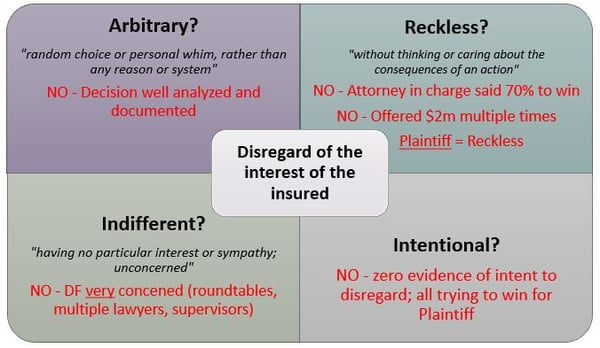
First Court recently completed jury research projects on a handful of bad faith cases, and developed some insight on how jurors understand and interpret the concept of bad faith. Since this can be a tricky topic for regular people to understand, we’ve shared a few insights on what we learned, and how to effectively communicate the important points to the laypeople in the jury box.
Jurors in a bad faith case survive being stricken in voir dire. They sit through the Openings. They listen to the claim handlers testify, and to all the opining of the experts. And while they may not be actively listening, they are at least present in the courtroom when the judge reads the jury instructions. Ready or not, it’s time for them to deliberate.
The question that we have found determines the outcome in a bad faith case: “What do these folks understand ‘bad faith’ actually means?”
We have had an opportunity to pose this question to jurors in venues around the country. You can see below how one group of our jurors answered the question in their own words:

Selfishness. Hurting others. Disregard. Nearly half of the jurors (43%) summed up their understanding of “bad faith” with the concept of selfishness, i.e. that the claim handler cared only, or too much, about what was best for the insurance company.
Another 37% understood “bad faith” to mean that the claim handler acted against the interests of the insured.
Keep in mind, the legal definition of bad faith varies by venue, so it's critical to tailor your approach to help jurors understand the applicable definition. Attorney Dale Swope of Swope Rodante in Tampa shared his perspective: "We have a definition in Florida common law that is MUCH easier to prove than trying to prove selfishness or an intention to hurt others. All we have to prove is that they failed to settle when they could have and should have. So none of that immoral or selfish conduct (which often is not actually present) is required."
Here's a short clip of our jurors deliberating on the question that illustrates how they thought through the issues:
Moral of the story: plaintiffs should avoid legalese when talking to a jury about bad faith. Instead, they should seek to boil down the jury instructions to the basic ideas of selfishness and hurting others.
Conversely, defense cases should keep the focus on how the applicable law defines bad faith, and how each element of that definition must be met. This can be hard to convey, so consider visual aids that explain how each element is met or not. Example:

Use simpler language and graphics to activate the key messaging for your side, and give your jurors a shot at understanding what the law means in the messy theatre of a bad faith trial. If you handle bad faith litigation and are interested in developing more tailored insights for your cases, let's find a time to talk!

Jun 3, 2019 3:30:08 PM




Comments